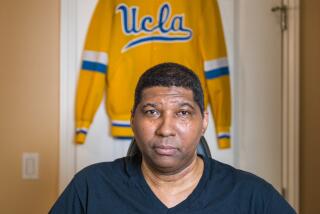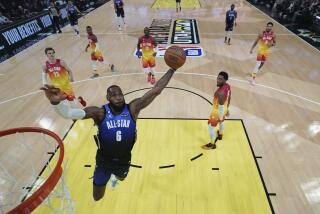To Hell and Back : Wickersham Playing Basketball Again After Battling Cancer
- Share via
LA HABRA — When the La Habra High School boys’ basketball team plays, a sharp observer might notice a worn “32” stenciled on each player’s sneakers. No. 32 was worn last year at La Habra by Wendell Wickersham; it also happens to be Magic Johnson’s number, and it’s a fitting coincidence. After emerging from a complicated and exhausting 10-month battle with a rare and deadly form of cancer, Wickersham has been called “Magic” just by managing to survive.
Early last March, Wendell Wickersham had plenty of reasons to be a typically carefree and optimistic teen-ager.
As a 6-foot-5 1/2, 180-pound junior, he had averaged 17.6 points per game, been named All-Freeway League and attracted the attention of coaches at Stanford, Notre Dame, Army, UC Santa Barbara, UC Irvine and San Diego State.
“I was looking forward to playing summer league basketball,” Wickersham said recently at his home in La Habra. “Basketball is my favorite sport.”
In addition to basketball, Wickersham was playing third base for the varsity baseball team. He had been an All-Freeway honorable mention as a sophomore, but this baseball season would be extremely short-lived.
“I was having difficulty with urination,” Wickersham recalled. “I went to the doctor, and he sent me to St. Jude (Medical Center), and they ran a biopsy on me.”
On March 9, Wickersham was found to have embryonal rhabdomyosarcoma of the soft red muscle tissue inside his prostate gland, and it was restricting his urinary tract.
Wickersham was hospitalized March 13 in the Kenneth Norris Jr. Cancer Hospital and Research Institute at the Los Angeles County-USC Medical Center. After a week of tests, he started making daily trips from his home to the hospital for chemotherapy.
“They started chemotherapy directed at the tumor,” Wickersham said. “I’d throw up twice in the car on the way up to the hospital, and then I’d throw up afterward. After a while, I started getting used to it.
“I had to quit school. I celebrated my 17th birthday (March 16) with a barf bucket.”
Wickersham’s initial shock turned to disbelief, then anger.
“At first, I didn’t really believe it,” he said. “I didn’t really believe it was that serious. Then I started to ask myself, why me?”
Wickersham’s mother, Jody, said: “Dr. (Don) Skinner told Wendell that this would be the worst year of your life. They said it would be a rough road. It was a rough road all right. It was a 10-month road to hell.”
The Kenneth Norris Jr. facility opened in April, 1983. It is the only one in the southwestern United States built exclusively for cancer research and patient care. The third and fourth floors contain a 60-bed hospital solely for cancer patients, particularly those afflicted with the disease in the urinary tract.
Dr. John Daniels, an oncologist, and Skinner, a nationally renowned urologist, became deeply involved in Wickersham’s treatment.
“ Embryonal rhabdomyosarcoma is a relatively rare form of cancer that is unusual at his age,” Daniels said. “It is more common in younger children between the ages of 2 and 6. In younger children, the cure rate is about 60% to 80%. For someone older, the cure rate is much lower. It’s so sporadic, we don’t have any data on it.”
So dangerous was Wickersham’s condition, doctors launched an all-out assault. Wickersham would undergo two types of chemotherapy, including one directed at the tumor through his arteries, along with extensive surgery, radiation therapy and a bone marrow transplant.
“All of the leading-edge treatments were used,” Daniels said. “It was quite complex, as complex as it ever gets. Now we’re on the wait.”
On top of all the complexities, there were complications.
“When they first started chemo, some of the solution leaked out of his artery and into the surface blood vessels and it burned a hole in the side of his pelvic area,” Jody Wickersham said.
“I couldn’t sit for a month,” Wendell recalled.
Said Daniels: “We don’t do this type of treatment often. It was a difficult area to pull off that type of therapy. It was a big risk.”
As the treatment progressed, Wickersham experienced the usual hair loss, and his weight dropped to 137 pounds.
“I’ve always looked skinny,” he said. “I just stayed in the house. It wasn’t easy to stay up for long periods of time.”
On June 12, Wickersham underwent 9 1/2 hours of surgery in which doctors removed his prostate gland, 50 lymph nodes and other surrounding tissue that might have been exposed to the cancer. Although surgeons considered the operation a success, Wickersham had to endure another extremely painful side effect after being strapped to an apparatus with his legs in an awkward position during the surgery.
“There was nerve damage to my lower legs,” Wickersham said. “I was numb from the knees down, and I couldn’t move my feet. It took a couple of weeks before I could move my toes.”
Originally, Wickersham was supposed to spend four weeks at home before the start of radiation therapy. Instead, he was back in the hospital after two so doctors could perform a spinal bloc to determine the extent of the damage.
“It was quite a problem,” Daniels said. “It happens sometimes. We try to avoid it. It’s part of the risk of a long surgery. The surgery was in a complex area, and extensive reconstruction was involved. He had the best surgeon in the world in that area in Dr. Skinner. No one else could have pulled it off.”
But Wickersham was frustrated nonetheless.
“They never said anything could go wrong,” Wendell said, “so I was real mad. I was worried about ever playing basketball again. That was the most painful part of the ordeal.”
In September, despite the fact he still was nearly immobilized by excruciating pain in his size-15 feet, Wickersham began five weeks of daily commuting to Los Angeles for radiation therapy.
“Every day the La Habra Fire Department came by to move me from the house to the car, and then they’d come back in the afternoon to move me from the car to the house again,” Wickersham said. “Finally, after two weeks, I got some knee pads so I could crawl on all fours to and from the car.”
By the end of radiation treatments, Wickersham could walk again.
“I was really relieved,” he said. “It was a sign of progress.”
“One can be optimistic about his recovery,” Daniels said. “The soft tissue damage has healed and the nerve damage will go away, but it’ll take a long time. Fortunately, he’s young.”
By Thanksgiving weekend, Wickersham was ready for the next phase of his treatment--the bone marrow transplant. In August, some of his own marrow was extracted and frozen to be reimplanted to boost his immunization system.
“It was supposed to be horrible, but actually it was the easiest part of the whole treatment,” Wickersham said. “The doctors said I was the second-quickest guy out of there. I got sick once or twice, but I never ran a fever. I brought my Michael Jordan posters, Nintendo games, VCR and Nerf Hoop because I expected to be there a month to a month and a half, but I got out in 17 days.
“That’s when the doctors started calling me ‘Magic Wickersham.’ ”
In December, on Friday the 13th, Wickersham’s treatment finally ended.
“It’ll take time for things to get back to normal,” Wickersham said. “My feet will have to come back naturally. I can walk around now. I’m using the (stair machine) in my garage and shooting hoops at practice at La Habra High School. I weigh about 155 pounds, but I’d like to gain another 25 or 30 pounds.”
Rusty Volker, a La Habra teammate, is glad to see his old buddy back again.
“I spent time with him while he was going through chemotherapy, and it seemed like he didn’t want to do things and wanted to keep to himself,” Volker said. “Now he’s coming out of his shell. He’s really changed since his bone marrow transplant.
“Before, I didn’t want to say anything about his hair, but the other day, while we were driving by a barber shop, he joked that he should stop and have them ‘take a little off the top.’ We kid around a lot and have a good time when we’re together.”
La Habra basketball Coach Frank McCarroll is relieved to see Wickersham back attending his team’s practice sessions.
“We’re glad he’s around and alive and kicking,” McCarroll said. “He’s my first big-time basketball prospect. He’s a good student and the well-rounded kind of kid I’d like to see my son grow up to be like. This makes you question why things happen they way they do.”
Two weeks ago, the Southern Section office approved Wickersham’s application for eligibility to play next season.
“I really believe he’ll be playing next year,” Volker says, “as soon as he gets his muscle back. He loves basketball so much. He loves to watch it when he’s not playing it. As soon as he gets out on the court, it’ll all come back to him. In practice, he hasn’t lost his shooting touch.”
Now the Wickershams and the doctors will have to watch and wait.
“We’re very hopeful, but he’s not out of the woods yet,” Daniels said.
Every three months for the next two years, Wickersham will undergo a CAT scan and chest X-ray, and the exams will continue for years after that on a less frequent basis.
With insurance benefits exhausted, Jody Wickersham is trying to find a physical therapist who can donate time and facilities to aid Wendell’s rehabilitation. Wendell’s father, Steve, has about $500,000 in coverage through his employer, a heating and air conditioning contractor, she says.
But the cost of the bone marrow transplant alone was $247,000.
“The institute has been very understanding,” she said. “I think the doctors were magnificent. They cured Wendell’s cancer. If we have to sell the house and live on the street, it’ll all be worth it. Wendell is alive!”
Wickersham’s eyes got watery as he finished describing the horror of his 10-month ordeal. But he sums it up with a plain-spoken simplicity:
“Life is the most valuable thing you have. You should always be grateful for your health.”
More to Read
Go beyond the scoreboard
Get the latest on L.A.'s teams in the daily Sports Report newsletter.
You may occasionally receive promotional content from the Los Angeles Times.










